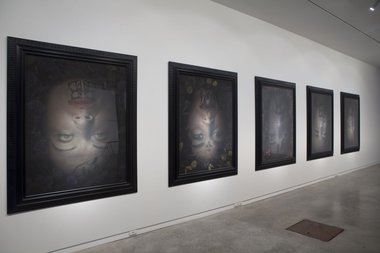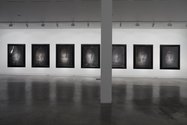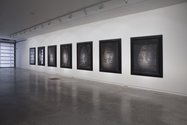John Hurrell – 17 October, 2012
We have this exhibition of portraits of young Ngai Tahu women, each with moko kauae (chin tattoo), photographed while lying down, looking back at the camera upside down. The images of their inverted faces are big, seven of them lined up in a row on a long wall. Because of the scale and number the show is quite imposing, indeed a little unsettling. In fact it's decidedly provocative, loaded with interpretative possibilities.
Auckland
Fiona Pardington
EREWHON: Left for Dead in the Field of Dreams
21 September - 20 October 2012
Fiona Pardington is one of the few photographers who, with her work practice focussing on different series of related images, still manages to surprise her audiences with new projects. Her inventive imagination succeeds in keeping them guessing. You never have the sense of products being trotted out.
So now we have this exhibition of portraits of young Ngai Tahu women, each with moko kauae (chin tattoo), photographed while lying down, looking back at the camera upside down. The images of their inverted faces are big, seven of them lined up in a row on the long lefthand wall of the downstairs Two Rooms Gallery. Because of the scale and number the show is quite imposing, indeed a little unsettling. In fact, when you think about it, seven women on their backs: it’s decidedly provocative, loaded with interpretative possibilities. That one could be sexual is enhanced by the amused twinkle in their eyes and the beauty of their accoutrements, such as flowers and golden seaweed.
Pardington’s description of their expressions in the gallery handout emphasises traditional Maori symbolism and a motivation quite different. Seaweed is a symbolic link to a higher spiritual reality, and the fact they that they are on their backs indicates their birth into this earthly realm. She also discusses the concepts within female facial expression (during waiata and haka) of potete and pukana, the two being closed and then open ‘glaring’ eyes with ‘a tightly held mouth’. Other eye expressions with an outward or downward gaze Pardington has based on portraits.
These large images are highly ambiguous, not only in the suggestion of desire within the spiritual symbolism but also within the notion of ‘Maoriness’ and what that involves in terms of so-called ‘defining’ physical attributes of eye and skin colour. There is also the ‘fuzziness’ of the exhibition’s poetic title, EREWHON being ‘nowhere’ and horizontality meaning death as well as sleep. Except these ‘oracular goddess-women’ (as Pardington calls them) look very much alive. There is nothing remotely cadaverous about them. They are gorgeous and they know it. Their skin glows and their eyes sparkle.
These conceptually complex, sensual works make up a great set - seven portraits working well collectively as a sequence to walk past, ponder and linger. A powerful combination.
John Hurrell










 Advertising in this column
Advertising in this column Two Rooms presents a program of residencies and projects
Two Rooms presents a program of residencies and projects



This Discussion has 0 comments.
Comment
Participate
Register to Participate.
Sign in
Sign in to an existing account.